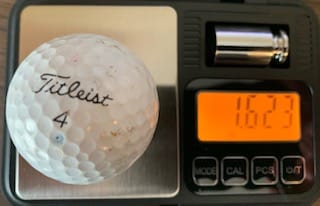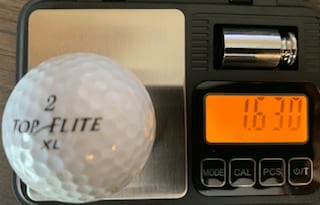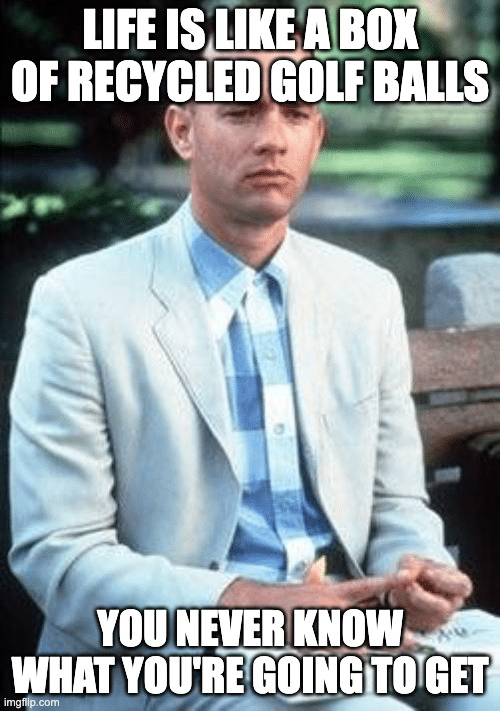Scuffed balls? Sitting in a garage for a decade? Buying from a local garage sale, or Facebook marketplace ad? Pulling them out of a pond? Do golf balls go bad – Yes, yes they do.
But, some may be perfectly fine to use, there are a few things you can look for including a quick bounce test, or a dime test. If you want to get super sophisticated, you can use a scale.
Let’s get into some of the details!
How Long Do golf balls last?
When stored properly, golf balls can certainly last a decade or more. The downside, however, is that you’ll miss out on some of the technological advances of modern golf balls. But honestly, that might not really make all that big of a difference.
Stored properly? If they are indoors, not exposed to the elements and/or major temperature fluctuations, unused golf balls will maintain their original performance capability for many many years.
If they’ve been kept in a garage, and exposed to hot/cold temperature fluctuations, it can certainly affect their performance.
Pulled from a pond? Used golf balls? Beware!! More on this below…
How to Tell if a Golf Ball is no Longer Good
There are a few ways to tell if a golf ball is no longer good
Bounce test
Dime test
Weight testing
Bounce Test
Probably one of the most non-scientific tests we can use, but also one of the easiest and more reliable.
Take your golf ball in question, hold it at eye level, and drop it onto the concrete. Does it bounce up to your chest? If not, it’s probably no good.
For comparison purposes, you can drop a new golf ball beside it and compare. If the ball in question comes up short, it’s likely going to come up short off the tee!
Dime Test
Five pence, a dime, 2 cent euro…a small coin. This only works for scuff marks. Essentially, if your golf ball has a scuff mark that is larger than a small coin, it can have a measurable effect on overall golf ball performance.
According to golf ball researchers at MyGolfSpy, a scuff on the cover that is normally associated with hitting cart paths can have a significant impact on carry distance, spin axis, and cause a ball to travel significantly offline.
What if you have a ball in play that bounced off of a cart path? Testing showed the ball will move in the opposite direction of the scuff. So if the scuff mark is on the right side of the ball as you look at the target, expect it to move left.
Bottom line – If the scuff is the size of a small coin or larger, especially if it is more than just a slight surface disruption, toss it as soon as you can!
Weight Testing
Ok, I know most people are not going to carry a scale with them. And most probably don’t even have a small enough scale to measure this…but it’s worth noting anyway.
USGA regulations state a golf ball cannot be greater than 1.62 ounces in weight. Most golf balls on the market absolutely comply with this standard. So, when you find a ball that is above that weight, it’s probably bad!
When a ball is overweight, it’s likely due to absorption of water after sitting at the bottom of a pond, or in the woods on the wet ground for however long.
You certainly don’t need to carry a scale with you. These balls will oftentimes come up short on the bounce test.

If you do have a scale and you make a habit of picking up whatever balls you come across – give them a quick weight check! Anything over 1.62 ounces can mean they’ve absorbed some water. I’d give them the bounce test too.
Can Golf Balls get Water Logged?
Golf balls can absolutely get waterlogged. I have a small bucket of golf balls from one of the ponds at my local club. These are generally used by one of the kids who are just starting to play. Whether they look like new golf balls or old golf balls, every single one of them seems to be overweight and fails the bounce test. Here is a handful I’ve tested.



If you follow the advice – “Don’t pull it out unless you see it go in” – you’ll probably be better off.
Are recycled golf balls any good?
Recycled golf balls, used golf balls, refurbished golf balls – pretty much all in the same category in my opinion. I’d stay away from most of them!
But honestly, it really depends on what you are looking for in a round of golf. If you don’t care about the score, don’t care about improving your game, and just want to go out with a group and have some fun – have your fun and there is no need to buy expensive equipment.
That being said, I still think you are far better off buying new golf balls in this case.
Explore these affordable golf ball options for your game
The problem with recycled balls is – you never know what you’re going to get.
If you’ve been on golf twitter for any length of time, you’ve probably come across images of “Chrome Soft” golf balls where you can actually see through the paint and it’s a Pinnacle.

I think there are some reputable companies out there who are honest and truly trying to deliver good products to customers. So if you’re going to buy used, check out my post on the best place to buy used golf balls.
What to do with your golf balls once they “go bad”
Use them for practice
Donate them to a local second-hand shop
Give them to your pro shop
My favorite thing to do with golf balls that have been scuffed is to simply throw them in my shag bag. Using them on the practice green and chipping areas works perfectly. The scuffs aren’t going to have a big enough impact in those short distances…and I don’t beat up a new ball while practicing sand shots or chipping in general.
Donating them to a local thrift shop, or a Play it Again Sports can help pass along the game in an affordable way to others as well. Even your local pro shop, many of them will have a bin of used balls that other golfers may want to use.
Unfortunately, there really is no way to recycle golf balls, other than getting them to another player who wants to use them. The only other option, other than throwing them in the trash, would be to use them for crafts or donating them to a group who will use them that way.
Storing golf balls so they don’t go bad
A modern golf ball can last for years if kept in the right conditions. Put them inside your house, in a closet or a storage area that is not exposed to extreme temperature fluctuations or direct sunlight. They will certainly have a longer shelf life in these conditions.
Keeping them in a garage, shed, or even your car is not a good idea, especially for a long period of time. Side-note – Don’t keep your clubs in these areas either. Your grips will suffer!
Final Thoughts
Golf balls can absolutely go bad and there are a couple of simple steps you can take to determine if they have. The bounce test, dime test, or even weighing them. A compromised golf ball will not perform to its original specs.
If you have some golf balls that have gone bad, you can donate them or use them in your own practice, depending on how “bad” they are. A scuff – Use them on the chipping area. Water logged – toss em’
If you need to store them for a while, keep them in a temperature controlled area and away from direct sunlight. They’ll keep for many years.
Good luck on the golf course!
